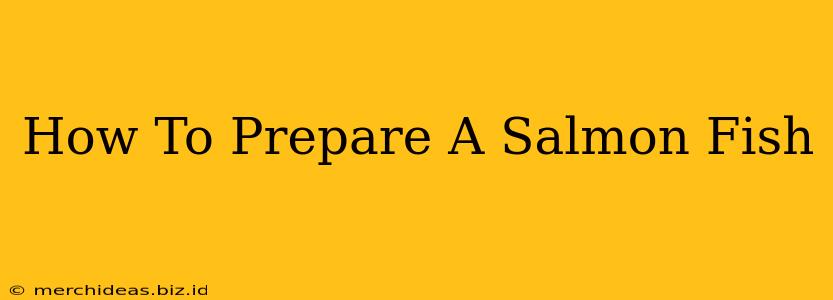Salmon is a culinary superstar, prized for its rich flavor, beautiful pink hue, and impressive nutritional profile. Packed with omega-3 fatty acids, protein, and vitamins, it's a healthy and delicious addition to any diet. But knowing how to prepare salmon to bring out its best can feel daunting. This comprehensive guide will walk you through various cooking methods, ensuring you achieve perfectly cooked salmon every time.
Choosing Your Salmon
Before you even think about cooking, selecting the right salmon is crucial. Look for these key indicators:
- Color: The flesh should be a vibrant pink-orange, with minimal graying. A dull color suggests the fish may not be fresh.
- Smell: Fresh salmon should smell mildly of the sea, not fishy or ammonia-like. A strong, unpleasant smell indicates spoilage.
- Texture: The flesh should be firm and springy to the touch, not mushy or flabby.
You can find salmon in various forms:
- Fresh fillets: Offer the most flexibility in cooking methods.
- Frozen fillets: A convenient option, ensuring consistent quality. Just be sure to thaw it completely before cooking.
- Salmon steaks: Thicker cuts, ideal for grilling or pan-searing.
- Canned salmon: A pantry staple perfect for quick meals (though the texture differs from fresh).
Cooking Methods: Unleash the Salmon's Potential
There are countless ways to prepare salmon, each offering a unique flavor and texture. Here are some popular methods:
1. Pan-Seared Salmon: Crispy Skin, Flaky Flesh
Pan-searing creates a beautiful, crispy skin and a perfectly cooked interior. Here's how:
- Pat the salmon dry: This helps achieve a crispy skin.
- Season generously: Salt, pepper, and your favorite herbs are a great start.
- High heat: Use medium-high heat and a little oil (olive oil or avocado oil works well).
- Skin-side down first: Sear the skin for 3-4 minutes until golden brown and crispy.
- Flip and finish: Cook for another 2-4 minutes, depending on thickness, until cooked through.
2. Baked Salmon: Simple & Foolproof
Baking salmon is incredibly easy and yields moist, tender results.
- Preheat oven to 375°F (190°C).
- Place salmon on a baking sheet lined with parchment paper.
- Season generously.
- Bake for 12-15 minutes, or until cooked through. Cooking time depends on the thickness of the fillet.
3. Grilled Salmon: Smoky Flavor Perfection
Grilling imparts a smoky flavor that complements salmon beautifully.
- Preheat your grill to medium-high heat.
- Lightly oil the grates to prevent sticking.
- Grill for 4-6 minutes per side, depending on thickness. Use a fish spatula to carefully flip.
4. Broiled Salmon: Quick & Easy
Broiling is a fast cooking method ideal for weeknight meals.
- Preheat your broiler.
- Place salmon on a broiler pan lined with foil.
- Broil for 4-6 minutes per side, watching carefully to prevent burning.
Checking for Doneness
Overcooked salmon is dry and tough, so it's crucial to check for doneness properly. The internal temperature should reach 145°F (63°C). You can also check by gently flaking the flesh with a fork; it should flake easily when cooked through.
Serving Suggestions: Elevate Your Salmon Dish
Once cooked, the possibilities for serving are endless! Here are a few ideas:
- Simple & Elegant: Serve with a squeeze of lemon juice, fresh dill, and a side of roasted vegetables.
- Mediterranean Flair: Pair with olives, feta cheese, and a drizzle of olive oil.
- Asian-Inspired: Try a teriyaki glaze, soy sauce, and sesame seeds.
- Creamy Delight: Top with a creamy dill sauce or a lemon-caper butter.
Conclusion: Mastering Salmon Preparation
With a little practice and the right techniques, you can master the art of preparing delicious and healthy salmon. Experiment with different cooking methods and flavor combinations to discover your favorite ways to enjoy this culinary gem. Remember to always prioritize fresh, high-quality salmon for the best results!
